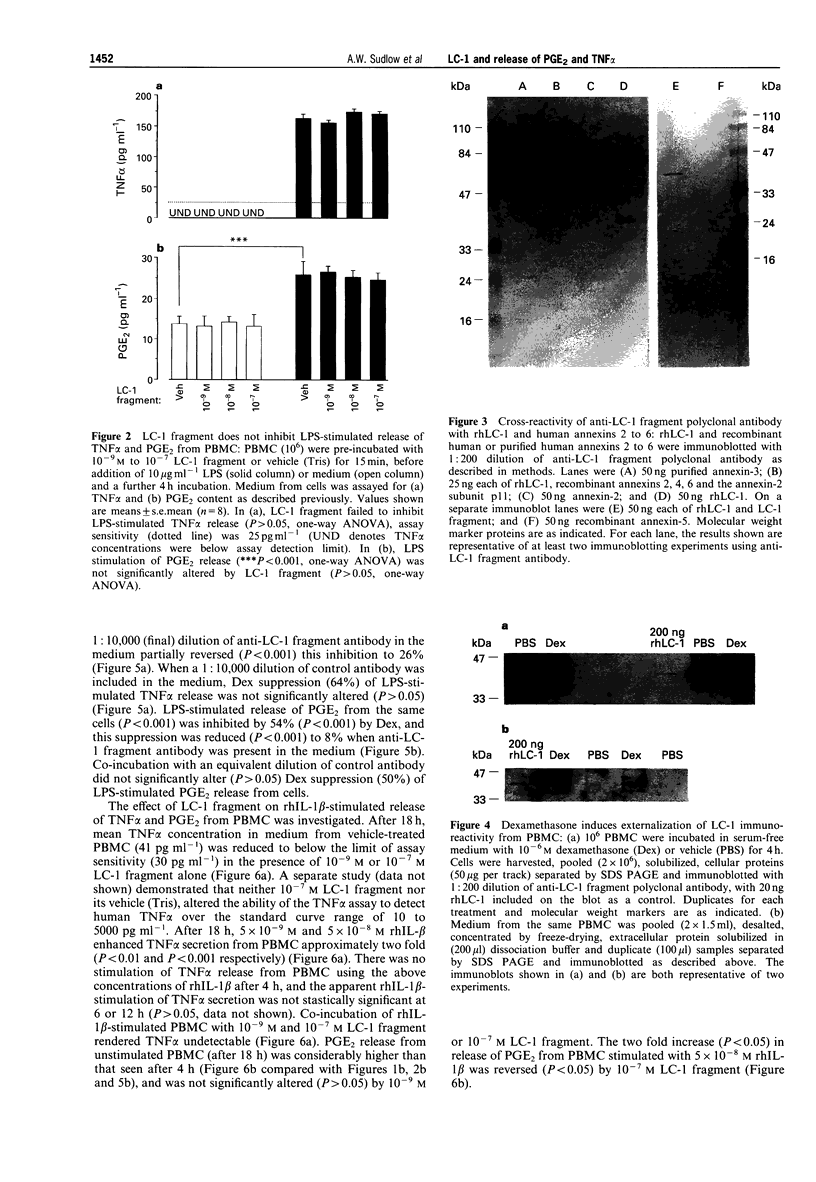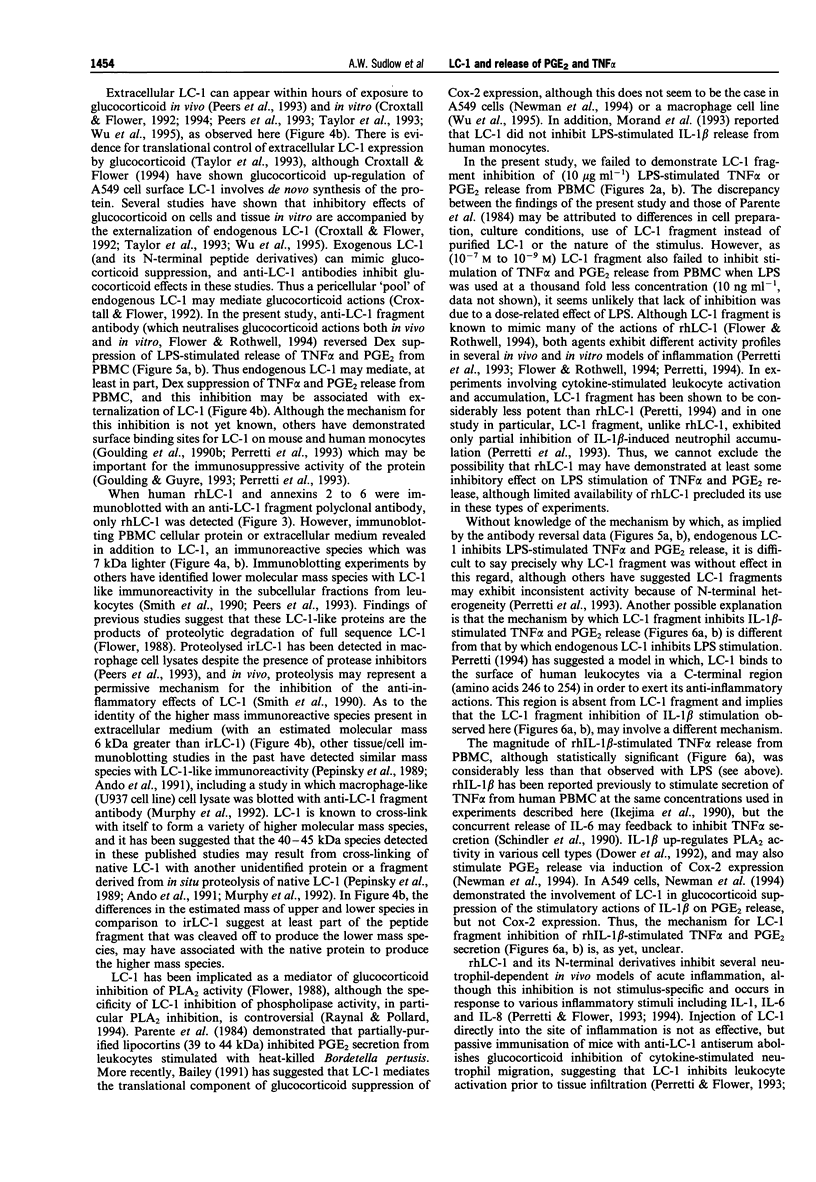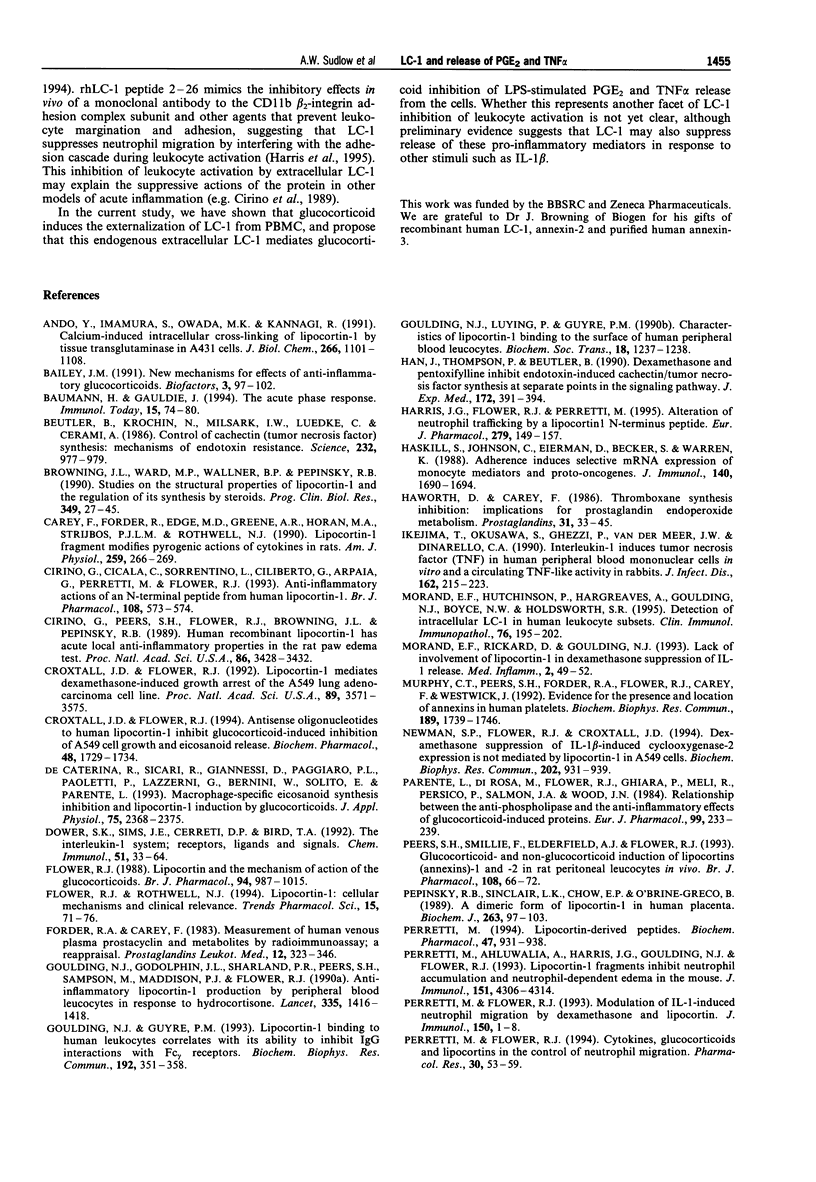Abstract
1.Lipocortin-1 and its N-terminal derivatives exert potent inhibitory actions in various models of acute inflammation. The present study examined the ability of lipocortin (LC)-1 to suppress the release of the acute pro-inflammatory mediators, tumour necrosis factor (TNF alpha) and prostaglandin E2 (PGE2) from human peripheral blood mononuclear cells (PBMC) stimulated with lipopolysaccharide (LPS) or recombinant human interleukin-1 beta (rhIL-1 beta). 2. LPS (10 micrograms ml-1) stimulated release of TNF alpha and PGE2 from PBMC was significantly inhibited by (4 h) co-incubation of the cells with 10(-6) M dexamethasone (Dex), but not with 10(-9) M to 10(-7) M of a N-terminal fragment (amino acids 1-188) of recombinant human LC-1 (LC-1 fragment). However, Dex suppression of LPS-stimulated TNF alpha and PGE2 secretion from PBMC was reversed when polyclonal antibody to LC-1 fragment (1:10,000 dilution) was included in the medium. rhIL-1 beta (5 x 10(-8) M)-stimulated release of TNF alpha and PGE2 from PBMC (after 18 h) was abolished by co-incubation of the cells with 10(-7) M LC-1 fragment. 3. After incubation with Dex (4 h), cellular proteins from PBMC were immunoblotted using anti-LC-1 fragment antibody (which showed to cross-reactivity with human annexins 2 to 6). Dex caused no increase in immunoreactive (ir)LC-1 content of PBMC, although there was a three fold increase in the amount of a lower mass species with LC-1-like immunoreactivity. This was accompanied by the appearance of irLC-1 in the extracellular medium. 4. The results of the present study implicate endogenous LC-1 in glucocorticoid suppression of TNF alpha and PGE2 release from human PBMC and suggest an extracellular site of action for LC-1. LC-1 may also inhibit rhIL-1 beta-stimulated TNF alpha and PGE2 secretion from PBMC.
Full text
PDF







Images in this article
Selected References
These references are in PubMed. This may not be the complete list of references from this article.
- Alexander J., Snoke K., Ruppert J., Sidney J., Wall M., Southwood S., Oseroff C., Arrhenius T., Gaeta F. C., Colón S. M. Functional consequences of engagement of the T cell receptor by low affinity ligands. J Immunol. 1993 Jan 1;150(1):1–7. [PubMed] [Google Scholar]
- Ando Y., Imamura S., Owada M. K., Kannagi R. Calcium-induced intracellular cross-linking of lipocortin I by tissue transglutaminase in A431 cells. Augmentation by membrane phospholipids. J Biol Chem. 1991 Jan 15;266(2):1101–1108. [PubMed] [Google Scholar]
- Bailey J. M. New mechanisms for effects of anti-inflammatory glucocorticoids. Biofactors. 1991 Jun;3(2):97–102. [PubMed] [Google Scholar]
- Baumann H., Gauldie J. The acute phase response. Immunol Today. 1994 Feb;15(2):74–80. doi: 10.1016/0167-5699(94)90137-6. [DOI] [PubMed] [Google Scholar]
- Beutler B., Krochin N., Milsark I. W., Luedke C., Cerami A. Control of cachectin (tumor necrosis factor) synthesis: mechanisms of endotoxin resistance. Science. 1986 May 23;232(4753):977–980. doi: 10.1126/science.3754653. [DOI] [PubMed] [Google Scholar]
- Browning J. L., Ward M. P., Wallner B. P., Pepinsky R. B. Studies on the structural properties of lipocortin-1 and the regulation of its synthesis by steroids. Prog Clin Biol Res. 1990;349:27–45. [PubMed] [Google Scholar]
- Cirino G., Cicala C., Sorrentino L., Ciliberto G., Arpaia G., Perretti M., Flower R. J. Anti-inflammatory actions of an N-terminal peptide from human lipocortin 1. Br J Pharmacol. 1993 Mar;108(3):573–574. doi: 10.1111/j.1476-5381.1993.tb12843.x. [DOI] [PMC free article] [PubMed] [Google Scholar]
- Cirino G., Peers S. H., Flower R. J., Browning J. L., Pepinsky R. B. Human recombinant lipocortin 1 has acute local anti-inflammatory properties in the rat paw edema test. Proc Natl Acad Sci U S A. 1989 May;86(9):3428–3432. doi: 10.1073/pnas.86.9.3428. [DOI] [PMC free article] [PubMed] [Google Scholar]
- Croxtall J. D., Flower R. J. Antisense oligonucleotides to human lipocortin-1 inhibit glucocorticoid-induced inhibition of A549 cell growth and eicosanoid release. Biochem Pharmacol. 1994 Nov 1;48(9):1729–1734. doi: 10.1016/0006-2952(94)90458-8. [DOI] [PubMed] [Google Scholar]
- Croxtall J. D., Flower R. J. Lipocortin 1 mediates dexamethasone-induced growth arrest of the A549 lung adenocarcinoma cell line. Proc Natl Acad Sci U S A. 1992 Apr 15;89(8):3571–3575. doi: 10.1073/pnas.89.8.3571. [DOI] [PMC free article] [PubMed] [Google Scholar]
- De Caterina R., Sicari R., Giannessi D., Paggiaro P. L., Paoletti P., Lazzerini G., Bernini W., Solito E., Parente L. Macrophage-specific eicosanoid synthesis inhibition and lipocortin-1 induction by glucocorticoids. J Appl Physiol (1985) 1993 Dec;75(6):2368–2375. doi: 10.1152/jappl.1993.75.6.2368. [DOI] [PubMed] [Google Scholar]
- Dower S. K., Sims J. E., Cerretti D. P., Bird T. A. The interleukin-1 system: receptors, ligands and signals. Chem Immunol. 1992;51:33–64. [PubMed] [Google Scholar]
- Flower R. J. Eleventh Gaddum memorial lecture. Lipocortin and the mechanism of action of the glucocorticoids. Br J Pharmacol. 1988 Aug;94(4):987–1015. doi: 10.1111/j.1476-5381.1988.tb11614.x. [DOI] [PMC free article] [PubMed] [Google Scholar]
- Flower R. J., Rothwell N. J. Lipocortin-1: cellular mechanisms and clinical relevance. Trends Pharmacol Sci. 1994 Mar;15(3):71–76. doi: 10.1016/0165-6147(94)90281-x. [DOI] [PubMed] [Google Scholar]
- Forder R. A., Carey F. Measurement of human venous plasma prostacyclin and metabolites by radioimmunoassay: a reappraisal. Prostaglandins Leukot Med. 1983 Nov;12(3):323–346. doi: 10.1016/0262-1746(83)90011-2. [DOI] [PubMed] [Google Scholar]
- Goulding N. J., Godolphin J. L., Sharland P. R., Peers S. H., Sampson M., Maddison P. J., Flower R. J. Anti-inflammatory lipocortin 1 production by peripheral blood leucocytes in response to hydrocortisone. Lancet. 1990 Jun 16;335(8703):1416–1418. doi: 10.1016/0140-6736(90)91445-g. [DOI] [PubMed] [Google Scholar]
- Goulding N. J., Guyre P. M. Lipocortin 1 binding to human leukocytes correlates with its ability to inhibit IgG interactions with Fc gamma receptors. Biochem Biophys Res Commun. 1993 Apr 30;192(2):351–358. doi: 10.1006/bbrc.1993.1422. [DOI] [PubMed] [Google Scholar]
- Goulding N. J., Luying P., Guyre P. M. Characteristics of lipocortin 1 binding to the surface of human peripheral blood leucocytes. Biochem Soc Trans. 1990 Dec;18(6):1237–1238. doi: 10.1042/bst0181237. [DOI] [PubMed] [Google Scholar]
- Han J., Thompson P., Beutler B. Dexamethasone and pentoxifylline inhibit endotoxin-induced cachectin/tumor necrosis factor synthesis at separate points in the signaling pathway. J Exp Med. 1990 Jul 1;172(1):391–394. doi: 10.1084/jem.172.1.391. [DOI] [PMC free article] [PubMed] [Google Scholar]
- Harris J. G., Flower R. J., Perretti M. Alteration of neutrophil trafficking by a lipocortin 1 N-terminus peptide. Eur J Pharmacol. 1995 Jun 12;279(2-3):149–157. doi: 10.1016/0014-2999(95)00145-b. [DOI] [PubMed] [Google Scholar]
- Haskill S., Johnson C., Eierman D., Becker S., Warren K. Adherence induces selective mRNA expression of monocyte mediators and proto-oncogenes. J Immunol. 1988 Mar 1;140(5):1690–1694. [PubMed] [Google Scholar]
- Haworth D., Carey F. Thromboxane synthase inhibition: implications for prostaglandin endoperoxide metabolism. I. Characterisation of an acute intravenous challenge model to measure prostaglandin endoperoxide metabolism. Prostaglandins. 1986 Jan;31(1):33–45. doi: 10.1016/0090-6980(86)90223-6. [DOI] [PubMed] [Google Scholar]
- Ikejima T., Okusawa S., Ghezzi P., van der Meer J. W., Dinarello C. A. Interleukin-1 induces tumor necrosis factor (TNF) in human peripheral blood mononuclear cells in vitro and a circulating TNF-like activity in rabbits. J Infect Dis. 1990 Jul;162(1):215–223. doi: 10.1093/infdis/162.1.215. [DOI] [PubMed] [Google Scholar]
- Morand E. F., Hutchinson P., Hargreaves A., Goulding N. J., Boyce N. W., Holdsworth S. R. Detection of intracellular lipocortin 1 in human leukocyte subsets. Clin Immunol Immunopathol. 1995 Aug;76(2):195–202. doi: 10.1006/clin.1995.1115. [DOI] [PubMed] [Google Scholar]
- Murphy C. T., Peers S. H., Forder R. A., Flower R. J., Carey F., Westwick J. Evidence for the presence and location of annexins in human platelets. Biochem Biophys Res Commun. 1992 Dec 30;189(3):1739–1746. doi: 10.1016/0006-291x(92)90279-t. [DOI] [PubMed] [Google Scholar]
- Newman S. P., Flower R. J., Croxtall J. D. Dexamethasone suppression of IL-1 beta-induced cyclooxygenase 2 expression is not mediated by lipocortin-1 in A549 cells. Biochem Biophys Res Commun. 1994 Jul 29;202(2):931–939. doi: 10.1006/bbrc.1994.2019. [DOI] [PubMed] [Google Scholar]
- Parente L., Di Rosea M., Flower R. J., Ghiara P., Meli R., Persico P., Salmon J. A., Wood J. N. Relationship between the anti-phospholipase and anti-inflammatory effects of glucocorticoid-induced proteins. Eur J Pharmacol. 1984 Mar 23;99(2-3):233–239. doi: 10.1016/0014-2999(84)90246-2. [DOI] [PubMed] [Google Scholar]
- Peers S. H., Smillie F., Elderfield A. J., Flower R. J. Glucocorticoid-and non-glucocorticoid induction of lipocortins (annexins) 1 and 2 in rat peritoneal leucocytes in vivo. Br J Pharmacol. 1993 Jan;108(1):66–72. doi: 10.1111/j.1476-5381.1993.tb13441.x. [DOI] [PMC free article] [PubMed] [Google Scholar]
- Pepinsky R. B., Sinclair L. K., Chow E. P., O'Brine-Greco B. A dimeric form of lipocortin-1 in human placenta. Biochem J. 1989 Oct 1;263(1):97–103. doi: 10.1042/bj2630097. [DOI] [PMC free article] [PubMed] [Google Scholar]
- Perretti M., Ahluwalia A., Harris J. G., Goulding N. J., Flower R. J. Lipocortin-1 fragments inhibit neutrophil accumulation and neutrophil-dependent edema in the mouse. A qualitative comparison with an anti-CD11b monoclonal antibody. J Immunol. 1993 Oct 15;151(8):4306–4314. [PubMed] [Google Scholar]
- Perretti M., Flower R. J. Cytokines, glucocorticoids and lipocortins in the control of neutrophil migration. Pharmacol Res. 1994 Jul;30(1):53–59. doi: 10.1016/1043-6618(94)80087-1. [DOI] [PubMed] [Google Scholar]
- Perretti M. Lipocortin-derived peptides. Biochem Pharmacol. 1994 Mar 15;47(6):931–938. doi: 10.1016/0006-2952(94)90402-2. [DOI] [PubMed] [Google Scholar]
- Raynal P., Pollard H. B. Annexins: the problem of assessing the biological role for a gene family of multifunctional calcium- and phospholipid-binding proteins. Biochim Biophys Acta. 1994 Apr 5;1197(1):63–93. doi: 10.1016/0304-4157(94)90019-1. [DOI] [PubMed] [Google Scholar]
- Schindler R., Mancilla J., Endres S., Ghorbani R., Clark S. C., Dinarello C. A. Correlations and interactions in the production of interleukin-6 (IL-6), IL-1, and tumor necrosis factor (TNF) in human blood mononuclear cells: IL-6 suppresses IL-1 and TNF. Blood. 1990 Jan 1;75(1):40–47. [PubMed] [Google Scholar]
- Smith S. F., Tetley T. D., Guz A., Flower R. J. Detection of lipocortin 1 in human lung lavage fluid: lipocortin degradation as a possible proteolytic mechanism in the control of inflammatory mediators and inflammation. Environ Health Perspect. 1990 Apr;85:135–144. doi: 10.1289/ehp.85-1568329. [DOI] [PMC free article] [PubMed] [Google Scholar]
- Taylor A. D., Cowell A. M., Flower J., Buckingham J. C. Lipocortin 1 mediates an early inhibitory action of glucocorticoids on the secretion of ACTH by the rat anterior pituitary gland in vitro. Neuroendocrinology. 1993 Oct;58(4):430–439. doi: 10.1159/000126572. [DOI] [PubMed] [Google Scholar]
- Wu C. C., Croxtall J. D., Perretti M., Bryant C. E., Thiemermann C., Flower R. J., Vane J. R. Lipocortin 1 mediates the inhibition by dexamethasone of the induction by endotoxin of nitric oxide synthase in the rat. Proc Natl Acad Sci U S A. 1995 Apr 11;92(8):3473–3477. doi: 10.1073/pnas.92.8.3473. [DOI] [PMC free article] [PubMed] [Google Scholar]




